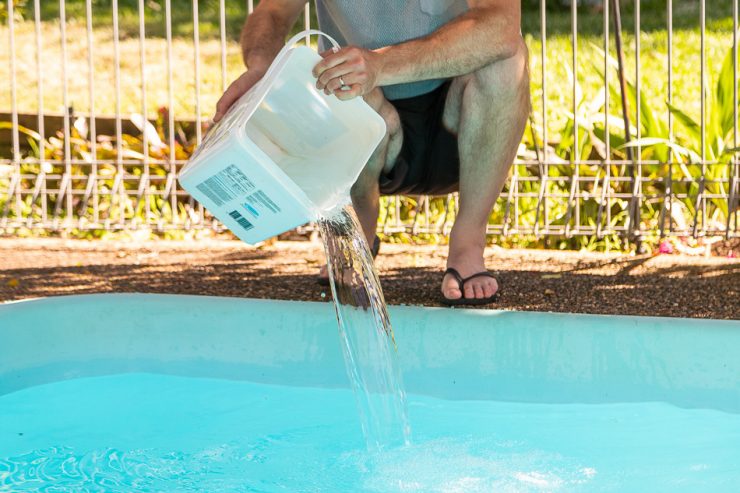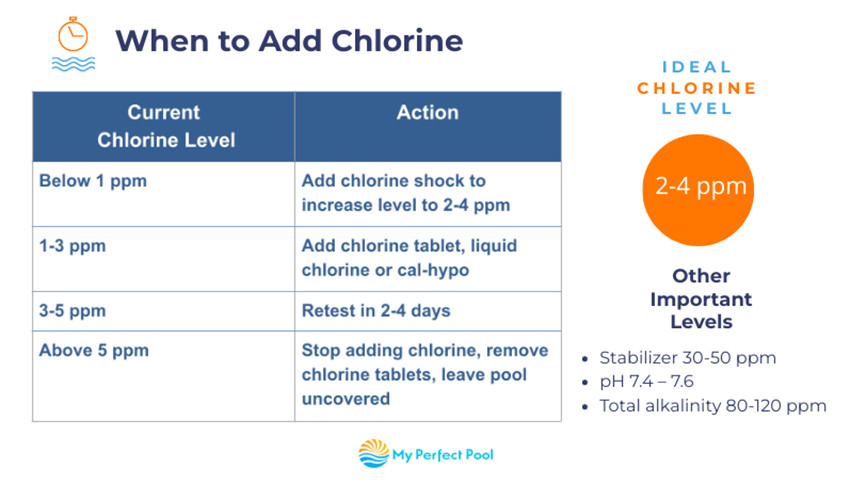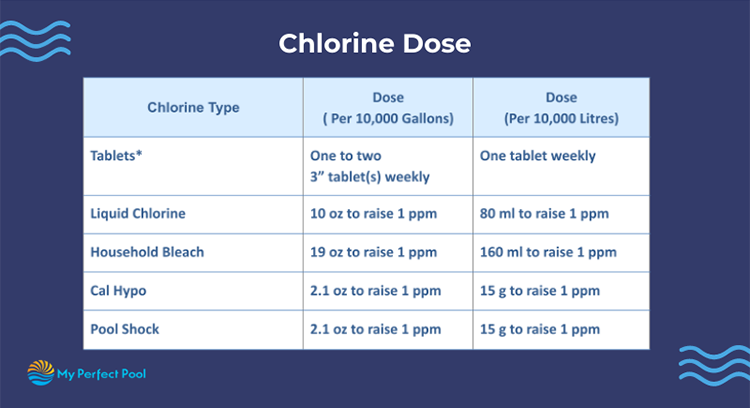Chlorine is the most effective chemical to add to a pool. It keeps the water sanitized, which prevents bacteria and algae from growing, and keeps the water sparkling clean.

Article Contents
Summarized: How Much Chlorine To Add To Pools
Free chlorine levels in a pool should be maintained at 2-4 ppm.
Some recommend 1-3 ppm, but this level leaves no room for factors such as rain, storms, heavy bather use, or temperature.
The above chlorine level assumes your pH level is correct at 7.4 to 7.6 and stabilizer (cyanuric acid) levels are 30-50 ppm.
To maintain this level, as a rule, use two 3” chlorine tablets per 10,000 gallons (38K liters) of water or 0.5 to 1.5 gallons (2 to 6 liters) of 12.5% liquid chlorine per week.
This will vary from pool to pool and depends on weather, pool use, pool size and many other factors.
The chart below summarizes how much chlorine to put in your pool. As a maintenance dose. New pools will need much more.
| Chlorine Type | How Often | How Much Chlorine (Per 10K Gallons) |
| Liquid chlorine 12.5% (Shock) | Weekly | 0.5 – 1.5 gallon per 10,000 gal |
| Household Bleach (aka Clorox ~6% strength) | Weekly | 1 – 3 gallons per 10,000 gallons |
| Chlorine Tablets (Dichlor) | 7-10 days, or when the tablets are disintegrated | Two 3-inch tablets per 10,000 gallons of water |
| Chlorine Tablets (Trichlor) | 7-10 days | Two 3 inch tablets per 10,000 gallons of water |
| Calcium Hypochlorite (granules) | Weekly during summer 1-2 weeks during other seasons | 10.5 ounces of granules per 10,000 gallons |
| Dichlor Granules | Weekly during summer 1-2 weeks during other seasons | 3 ounces per 10,000 gallons |
How Do You Know How Much Chlorine to Add to A Pool?
We’ll go into depth later. For now, just know that how much chlorine you add depends on three things:
- Type of Chlorine
- Current & Ideal Chlorine Level
- Pool Volume
1. Types of Chlorine
There are different types of chlorine and sanitation methods:
- Liquid chlorine
- Granular (calcium hypochlorite, trichlor, dichlor)
- Tablets (trichlor & dichlor) and;
- Chlorinators or salt generators
All types of chlorine perform the same function: they sanitize pool water to prevent bacteria growth and promote a healthy pool. Some chlorines are stronger than others and will require a different dose to maintain a chlorine level of 2-4 ppm (parts per million).
2. Current & Ideal Chlorine Levels

Your chlorine level should be between 2-4 ppm, though I recommend 5 ppm during the summer or rainy months because UV rays and rainwater dilute the chlorine.
Pool water needs to be tested weekly for proper chemical levels, and how out of balance the chlorine is determines how much chlorine you need to add.
Cyanuric acid (CYA), or stabilizer, is also a determining factor in chlorine levels because it bonds with the chlorine to protect it from deterioration, making it longer-lasting and more effective. To keep it simple, maintain 30-50 ppm of CYA.
3. Pool Volume
The volume of your pool determines the dose of chlorine needed, as well as the type and strength of chlorine you use. The more water you have, the more chlorine you must add to your swimming pool to keep it at 2-4 ppm.
Different Types of Pool Chlorine & Dosages

There’s a big difference between the different types of chlorine available for your pool. You will always need to add enough chlorine to maintain your chlorine level at 2-4 ppm, but how much chlorine you add depends on the type or strength.
The dose of chlorine is usually always listed as an amount per 10,000 gallons of pool water. To calculate the amount of chlorine for your pool, you’ll need to know your pool’s volume first.
The most common types of chlorine and sanitation systems for home pools are:
- Liquid Chlorine (12.5%)
- Bleach (aka Clorox)
- Calcium Hypochlorite (cal-hypo)
- Chlorine Tablets (dichlor, trichlor, cal-hypo)
- Salt Water Chlorine Generator (aka Chlorinator)
How Much Liquid Chlorine to Add
Liquid chlorine is an unstabilized sanitizer with 10-12.5% chlorine. It comes mixed with water and salt.
Add 10 oz of 12.5% strength liquid chlorine for 10,000 gallons of pool water to increase chlorine by 1 ppm.
Every week, for a 10,000-gallon pool, you’ll need to add 0.5 to 1.5 gallons of liquid chlorine (12.5% strength). This should be enough to maintain a 2-4 ppm chlorine level. But it does depend on your pool and environment.
How much chlorine you add per week depends on how low the levels are.
Here’s a chart showing you how much chlorine to add to raise chlorine levels by 1 ppm.
| Pool Volume | Chlorine Needed (12.5% strength) Weekly |
| 1,000 gallons (3,855 liters) | 1 oz (30 ml) |
| 5,000 gallons (18,927 liters) | 5 oz (150 ml) |
| 10,000 gallons (37,854 litres) | 10 oz (296 ml) |
| 15,000 gallons (56,781 liters) | 15 oz (444 ml) |
| 20,000 gallons (75,708 liters) | 20 oz (592 ml) |
If chlorine is around 2 ppm, I would add about 30 ounces per 10,000 gallons of pool water. This will increase free chlorine to around 5 ppm.
Liquid chlorine is best for weekly maintenance levels. For instance, if your chlorine is regularly in range but toward the lower end, this is good to use (if it’s a consistent problem, check the CYA levels). Liquid chlorine also has the added advantage of sanitizing as soon as it’s mixed into the water.
How Much Calcium Hypochlorite to Add
A 10,000-gallon pool needs 26 oz of calcium hypochlorite (cal-hypo) at 65% strength to raise the chlorine 1 ppm.
Here’s a chart showing how much cal-hypo chlorine raises chlorine by 1 ppm. If you would like to increase chlorine by 2 ppm, double the dose.
| Pool Volume | Calcium Hypochlorite 65% Strength (granules) Dose |
| 1,000 gallons | 0.2 oz |
| 5,000 gallons | 1 oz |
| 10,000 gallons | 2 oz |
| 15,000 gallons | 3 oz |
| 20,000 gallons | 4 oz |
Calcium hypochlorite granules are unstabilized concentrated granules with a chlorine strength of 65%. Commonly called cal hypo, this excellent sanitizer is highly effective at killing contaminants and keeping your pool crystal clear.
Due to its high strength, less is needed, and it lasts longer than regular liquid chlorine (12.5%).
How Many Chlorine Tablets to Add to the Pool
Use two 3” chlorine tablets per 10,000 gallons of pool water per week. Or 1-2 x 1” tablet(s) for pools with less than 5,000 gallons of water.
This charge shows an approximate weekly maintenance dose of chlorine tablets, depending on volume.
| Pool Volume | Chlorine Tablets Needed |
| 1,000 gallons | 1 x 1” tablet |
| 5,000 gallons | 1 x 3” tablet |
| 10,000 gallons | 2 x 3” tablets |
| 15,000 gallons | 3 x 3” tablets |
| 20,000 gallons | 4 x 3” tablets |
Chlorine tablets are sometimes called tabs or pucks, and they come in four different types of chlorine:
- Dichlor (stabilized)
- Dichlor (unstabilized)
- Trichlor (stabilized)
- Calcium Hypochlorite (unstabilized)
Chlorine tablets also come in two sizes:
- 3” for larger pools (>5000 gallons) and;
- 1” for smaller pools (<5000 gallons)
Which type you use is a personal preference. I prefer unstabilized because I have more control of the stabilizer levels, which don’t need to be adjusted too often. Stabilized chlorine can push your stabilizer levels too high.
To use chlorine tablets, you place the tablets in a “floater,” which floats around the pool and slowly dissolves the tablets. Or if they are cal-hypo tablets in a chlorine feeder or chlorinator, a chlorine delivery system plumbed into the pool lines.
Depending on your chlorine levels, 2-3 tablets should last 2-3 weeks. You should check the tablet levels when you perform your weekly maintenance.
Tablets are only meant to maintain the level of chlorine in a pool. If your pool is low on chlorine, you will need to add liquid chlorine or shock (cal-hypo) to raise the levels quickly.
How Many Trichlor Tablets to Add
Use two 3” trichlor tablets per 10,000 gallons of water approximately weekly.
| Pool Volume | Chlorine Tablets Needed |
| 1,000 gallons | 1 x 1” tablet |
| 5,000 gallons | 1 x 3” tablet |
| 10,000 gallons | 2 x 3” tablets |
| 15,000 gallons | 3 x 3” tablets |
| 20,000 gallons | 4 x 3” tablets |
Trichlor usually comes in tablet form and is a form of stabilized chlorine. They come in 3” tablets for large pools (over 5K gallons) and 1” for smaller pools. The chlorine dissolves slowly and is highly effective at sanitizing.
If your stabilized levels are high already, switch to an unstabilized chlorine.
How Many Dichlor Tablets to Add
To raise your chlorine 1-3 ppm, you will need to add two 3” dichlor tablets per 10,000 gallons of water.
| Pool Volume | Chlorine Tablets Needed |
| 1,000 gallons | 1 x 1” tablet |
| 5,000 gallons | 1 x 3” tablet |
| 10,000 gallons | 2 x 3” tablets |
| 15,000 gallons | 3 x 3” tablets |
| 20,000 gallons | 4 x 3” tablets |
Dichlor is a highly concentrated, stabilized chlorine that is available in granular or tablet form, but tablets are safer to use and far more common. They’re higher in stabilizer than trichlor tablets and dissolve quickly. Dichlor is also long-lasting due to the CYA levels and is great as a sanitizer and clarifier.
Final Thoughts on How Much Chlorine
By now, you should have a pretty good understanding of how much chlorine you need to add to your pool. Remember that you’ll need to take into account the type of chlorine you have, the size of your pool, the current chlorine level, and the desired level. If in doubt, look at the manufacturer’s directions on the pack too.

